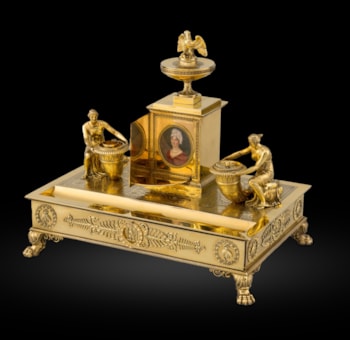The crest is that of William, Viscount and Baron Lowther (1757-1844), created 1st Earl of Lonsdale in 1807. He married Augusta, eldest daughter of John, 9th Earl of Westmorland, in 1781. The Earl was a significant patron of the arts and commissioned the rebuilding of Lowther Castle. He was one of the great patrons of plate in the Regency era, including owning one of the Shields of Achilles (now Anglesey Abbey, National Trust).
This group of four salt cellars was originally part of a group of twelve, hallmarked for 1803, 1804, 1808 and 1810, which was dispersed in the Lonsdale sale in 1947. They can be compared to a group of 36 salt cellars in the Royal Collection, designed in an even more pronounced Egyptian taste with sphinx heads (RCIN 50821). These, part of the 'Grand Service', were produced by Digby Scott and Benjamin Smith, and Philip Rundell, between 1802-19 (see Carlton House: The Past Glories of George IV's Palace, 1991, p. 131, no. 92).

Lowther Castle
In the English Lake District, Lowther Castle is a particular gem. Its gardens were the envy of the north. The site of Lowther Castle has been occupied by the same family since 1150. Several different buildings have been and gone, the last of which was the castle itself. It was commissioned by William, 1st Earl of Lonsdale in 1806 and designed by the architect Robert Smirke. Smirke later became responsible for many great civic buildings in London including the British Museum. In its heyday, the castle was said to boast a room for every day of the year. There was a grand art collection, and the house was a celebrated landmark of the north.
William, 1st Earl of Lonsdale (1757-1844), by descent to
Lancelot, 6th Earl of Lonsdale O.B.E. (1867-1953), sold
Christie's, London, February 19-20, 1947, lot 220 (set of 12; £170 to M. Hedges)
Christie's, London, October 6, 1948, lot 81 (£60 to Black)
The partnership of Digby Scott and Benjamin Smith produced some of the greatest silver works of the early 19th century. Scott and Smith jointly ran workshops located in Greenwich, England from 1802 to 1807 and during their brief partnership were the principal suppliers of silver masterpieces to the esteemed firm of Rundell, Bridge & Rundell. At the time London's most prestigious firm, these jewellers and silversmiths supplied the official plate ordered by the Lord Chamberlain's office, and were the official "Jeweller, Gold and Silversmiths to the Crown" from 1798 to 1843. Working in the cusp of the late Georgian and early Regency periods, the works of Scott and Smith often feature elements of the classical revival style such as grapevines and rams' heads, all crafted in exquisite, sumptuous detail. One of their most renowned collaborative efforts, the Duke of York Baskets, created for Frederick Augustus (1763-1827), second son of George III, is currently on display at the Powerhouse Museum in Australia.
You May Also Like








































































